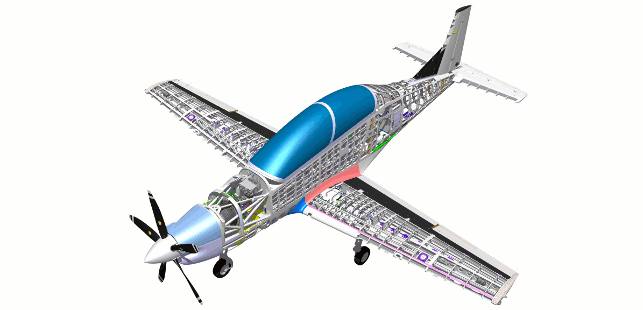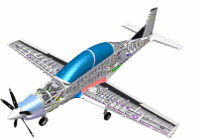Turkish Aerospace Industries (TAI) is Turkey’s centre of technology for the design, development, modernisation, manufacturing, integration and life cycle support of integrated aerospace systems, from fixed and rotary wing aircraft to Unmanned Aerial Vehicle (UAV) systems and space systems.

Turkish Aerospace engineers get fully optimised graphics regardless of their client hardware
TAI currently has over 1,500 engineers at its central facility in Ankara, but plans to double that number within the next few years. User hardware varies greatly, ranging from entry-level thin clients with standard office productivity applications (e.g. Internet Explorer and Microsoft Office) to advanced workstations with heavy CAD applications for design and visualisation (e.g. Siemens NX).
Each user requires dedicated graphics cards—both for the graphics-intensive applications on the professional-grade workstations, and to view CAD data on thin clients and business PCs over TAI’s secure Intranet, via applications such as Siemens PLM Viewer and Oracle AutoVue.
TAI’s IT department faced significant challenges in supporting varying hardware setups and dozens of different applications, and knew they needed to simplify before they continued expanding. Furthermore, with its previous 1:1 user-to-graphics card setup, TAI needed a way to increase user density and more efficiently allocate GPU power as needed to its growing pool of engineers.
“Virtual desktop infrastructure (VDI) and dynamic allocation of GPU power to virtual machines via vGPU™ became a necessity for our IT department,” explained Serdar Kaya, IT System Engineer, TAI.
“In this environment where we are constantly expanding, and our engineers require varying amounts of graphics power each day from project to project, simply buying and maintaining more workstations and more graphics cards became costly and unmanageable. We needed to be able to simplify overall and also increase our user density.”
TAI had already adopted Citrix’s XenDesktop and XenApp to begin shifting to a virtualised infrastructure—but graphics density and allotment remained hurdles.
Connecting up to the GRID
TAI turned to Nvidia GRID, the graphics-accelerated virtual desktop and application technology, to address its graphics-related issues.
TAI adopted servers equipped with GRID K1 boards to enable applications for viewing CAD models and office productivity in a virtualised environment; and adopted servers with GRID K2 boards to enable heavy CAD applications such as Siemens NX in a virtualised environment.
Nvidia’s GRID vGPU (virtual GPU) Manager allows up to eight users to simultaneously share a single GPU from both boards, which instantly increased TAI’s user density without compromising graphics performance.
Virtual GPU sharing allowed TAI to maximise the efficiency of its available resources. No longer tied to a 1:1 GPU setup, the IT department could allocate graphics power to a wide range of simultaneous users as needed.
The availability of this technology allowed TAI’s workforce to scale up while being easily manageable for the IT department, and without requiring additional space in the server room.
“A common problem we faced was that an engineer would be working on Project A where he might require additional memory or more graphics power than usual, so we install more RAM and higher-end graphics cards onto his workstation,” explained Kaya. “But then after a few weeks this engineer would switch over to Project B, which had lesser requirements, but it’s not necessarily worth it for us to uninstall the extra RAM or extra GPU. Now multiply that by thousands of engineers. Nvidia GRID allows us to optimise our hardware investments so that resources can be easily shared and transferred between users as needed —nothing goes to waste.”
Nvidia GRID also eliminated latency issues, providing a truly responsive and interactive user experience on graphicsintensive applications. Users experienced fully optimised graphics performance regardless of their hardware—thin clients, workstations, and more are supported.
“VDI and GRID make the job so much easier for our IT department, because GRID supports our entire range of users—from thin client hardware to advanced workstation hardware, and from basic productivity applications to professional design and visualisation applications,” said Kaya. “GRID really streamlined our IT support. I can now give our users a boost of GPU power on the fly. It’s as simple as allocating additional GPUs in XenServer, and the GPU upgrade is there once the virtual machine is powered up again.”
“Nvidia GRID is like nitrogen for virtual desktop infrastructure,” continued Kaya. “You use nitrogen in your car engine when you require an extra boost of power—and that’s exactly what GRID has done for our virtual machines.”
TAI plans to outfit its Ankara facility with several more GRID K1 and K2-equipped servers, to fully realise the benefits of virtual GPU technology for its growing user base. And with the recent release of Citrix XenDesktop 7, TAI can leverage new improvements for even more GRID functionality.
“Nvidia GRID is allowing TAI to expand efficiently,” said Kaya. “It supports our dynamic environment by optimising our available resources and eliminating strains on IT. I am eager to increase our number of GRID-equipped servers, so that we can share the benefits of the virtual GPU with as many of our users as possible.”
“With GRID, TAI has been able to enhance IT efficiency and performance, which reduces costs and improves productivity. This technology will help us to achieve our goals within the global aerospace industry,” concluded Gülsen Bayramusta, Manager of IT, TAI.
How Turkish Aerospace Industries is benefitting from Nvidia’s GRID technology
Default






